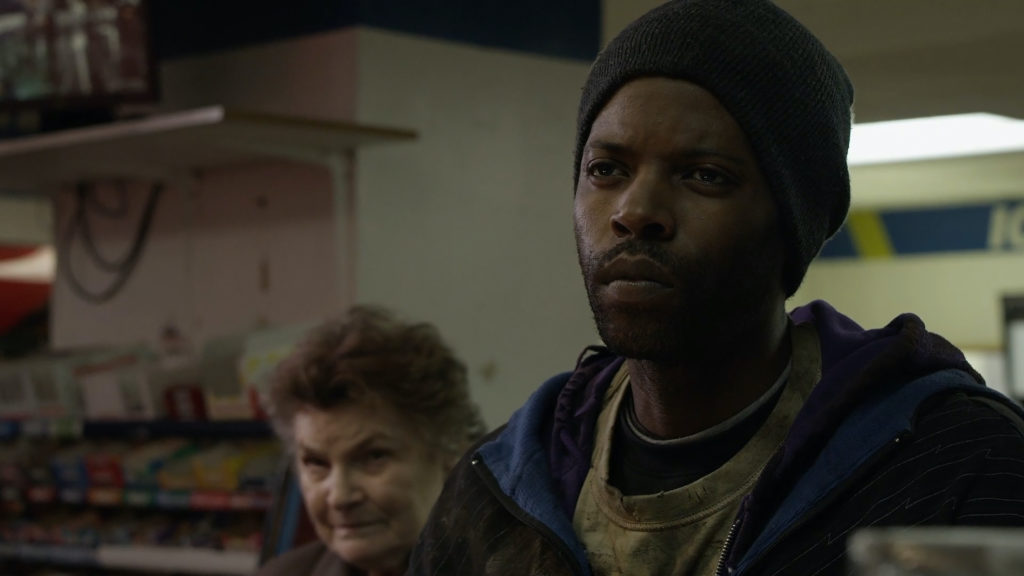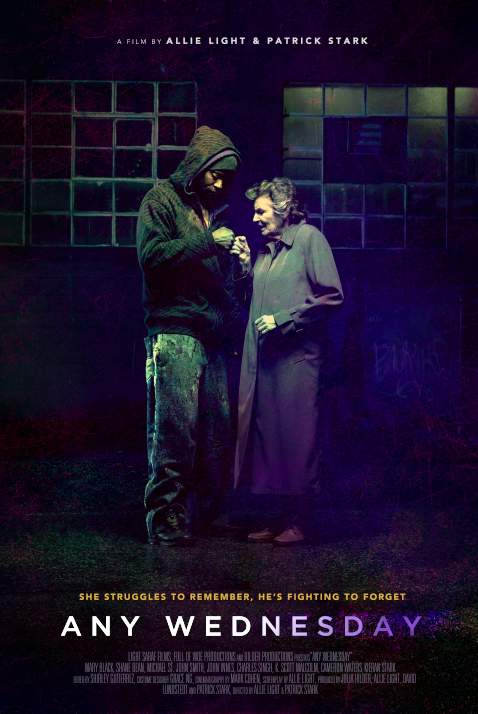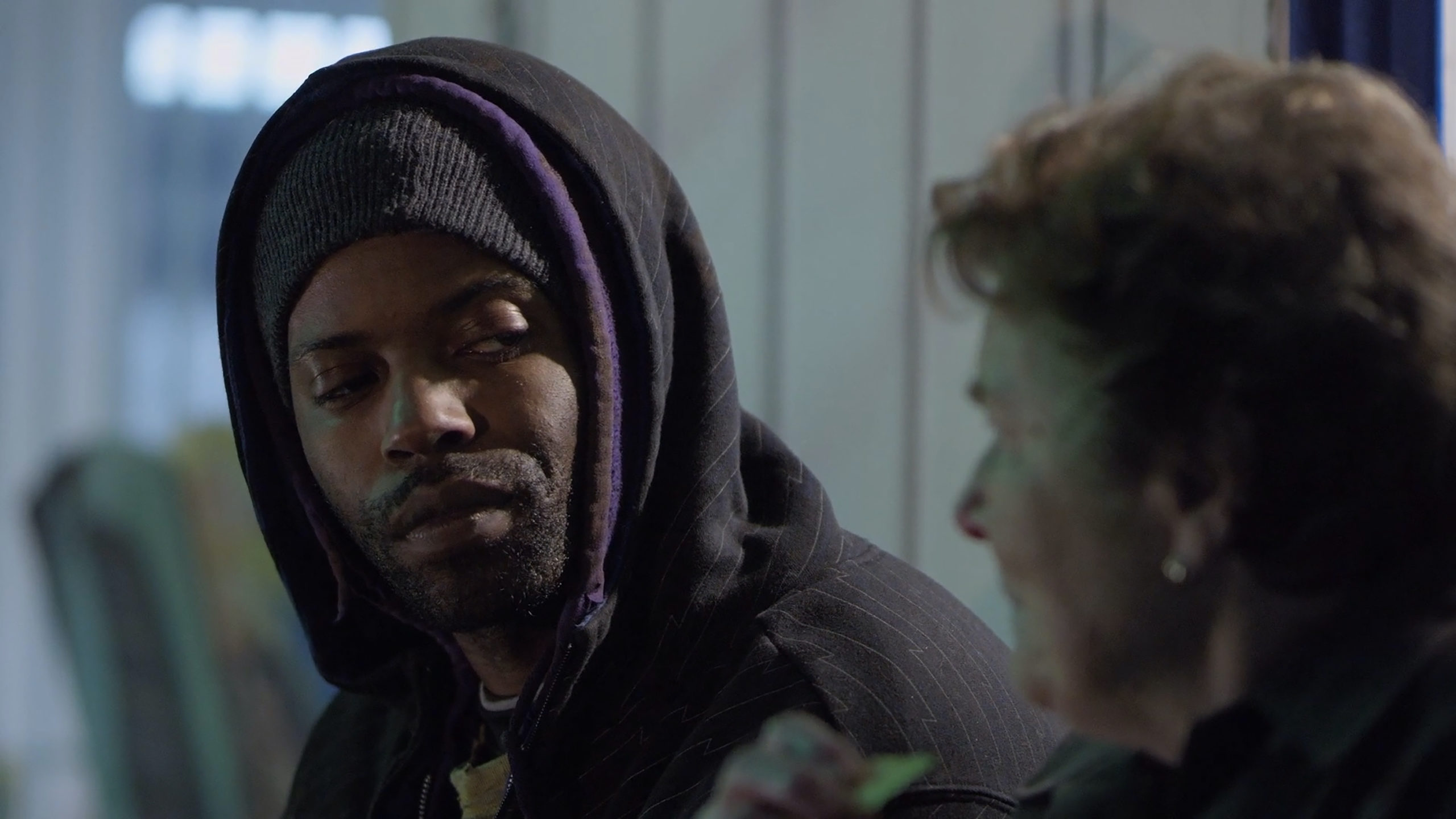It’s interesting how two people with two different perspectives can share an interesting connection. This is the case both given the film concept and the filming experience. Recently, I met with Patrick Stark, co-director of Any Wednesday, a dark but incredible tale of what happens when an elderly woman (Mary Black) who has trouble remembering meets a young homeless man (Shane Dean) who has trouble forgetting. Patrick told me a lot of interesting info about the film and what went into making it.
Have you been in a predicament similar to the film? It’s such a touchy subject.
No, I haven’t. I really look at the film as being two characters with two different conditions, PTSD and dementia and how their paths crossed. I feel like the film is dealing with mental illness in general. When I actually read the script by Allie, and how Agnes has dementia, that immediately resonated with me because of my grandmother who had dementia.And then with C-Mo, the homeless Iraq war vet it made me think of my nephew who was living on the streets of Vancouver’s east-end. He had schizophrenia, and was addicted to drugs. He passed away, his name was Benjamin. But he was surviving on the streets when I was reading the script. The characters meant something to me before I dove in.
What impact did you have in co-directing? Did you help with the creative process?
I didn’t really bring anything to the writing of the concept, as it was Allie’s script – the only thing I could bring was my take on it and having an ability to work with the actors. The actors brought something to that as well. Shane Dean had done research on PTSD. There’s a moment when C-Mo has a reaction to lightning and thunder, and he had to do it as realistically as possible, and so he created his own backstory for the character. Then Shane and I would meet, because Allie the co-director is in San Francisco creating her own notes, doing her own research, and preparing it her own way. But we brought to the film to Vancouver and we cast it here, so it’s all Canadian cast with all Canadian crew. I had the opportunity to work with Shane. He and I would meet and Shane would say “This is I’ve been doing. This is what I would bring to the character, the research I’ve done…” That way, the three of us were on the same page as to how his character should react and based on his backstory.
What was it like filming a driving scene with heavy rain?
*laughs* We controlled it, because you have to plan for rain, when there’s no rain. But you also have to plan on how to depict driving. When you have a tow shot, you need a camera car and need a lot of money. We didn’t have much money, we had a tight budget, but not for such specialized work, towing the car around while the actors just pretend to drive and talk. So we had to rely on poor man’s process: Find a confined space where we could make it rain with rain towers, use specialized lighting to run a light over their faces, shake the car, light it to look like nighttime so we’re not seeing anything distinctive going past the windows. What we’re seeing are tight shots, tight on one character, tight on the other. It’s dark, you see rain falling on the windows, but the car’s not really moving anywhere.
How did you get involved with this project with Allie?
Allie and I were introduced by a mutual friend who said to me, “You’re a documentary filmmaker, I know a documentary filmmaker in San Francisco who’s really prolific. You should talk, maybe you’ll really connect.” So I looked up Allie Light and what she had done. I said to myself, “Oh my gosh, she’s won an Academy Award, she won an Emmy!” I thought at least if I spoke to her, I’d learn something, and maybe in that conversation we would hit it off and maybe I’ll get another phone call. Perhaps she would mentor me in my documentary filmmaking. We started chatting about documentaries and then she talked about creating documentaries with her husband, who had subsequently who passed away in 2012. To help deal with her grief, Allie decided to turn to drama to help in her healing process. She ended up writing a novel and 4 short scripts in her 80s, which is quite a feat. It’s hard to write just one script let alone 4 short scripts. She then said, “There is one film that I would REALLY love to see made and that is Any Wednesday. I have a modest budget – fifty thousand for the film, but I don’t think anyone will be able to make it for that. I suggested, “Why don’t you bring it to Vancouver, I’ll help you, I don’t want anything else, I can make it happen. I know the crews, I know we have talented actors, we have the infrastructure here to pull it off here plus the exchange with the dollar. That budget is going to stretch, and help you make your movie.” She replied “Well, how about I fly to Vancouver, so I can meet you – if I like you, then maybe we can discuss making the movie.” She came up to Vancouver with her daughter Julia Hilder who became a co-producer on the film. Ultimately, we did hit it off and looked at some locations. She said yes, but she suggested that I co-direct this film with her, – I was honoured to have the chance.
She actually came to Vancouver four times. The first time to meet me, the second time for the casting session at the Sutton Place Hotel, and then two separate occasions for filming.
The first AD who broke down the script said this would be a seven day shoot. I said we couldn’t afford seven days, and we had to shoot it in four. *laughs* We did, but in the end we had a faulty B-camera. We ended up having to reshoot in the following summer, and re-shoot the driving scenes. We didn’t have money for rain towers so we had special effects bring in Hudson sprayers. It worked beautifully.
You said earlier you were on a budget, how did you get the film financed?
The initial budget came from Allie, and when we ran out of money, that’s when I picked up the surplus amount and paid off a few things here and there. It’s not easy to make a movie when money’s not there but we pulled it off and the film went back to San Francisco where it was edited.
How did you and Allie manage to balance the work of co-directing together?
I had a responsibility to fully understand the script, do my own research, and break down the shots, and create my own shot list. I even worked with a storyboard artist – I love to pre-visualize the various shots and we ended up storyboarding the entire movie. I needed to do that for myself – to be prepared as possible. At the same time, I wanted to respect that this is Allie’s original vision. The idea was that when we were set up to shoot our masters and our coverage, I wanted to make sure Allie got what she wanted. Then, I got would go in, and suggest alternatives. There were a lot of options in the editing room. I pulled double duty, as Allie’s co-director and carried the additional duties of assistant directing. I had been a career A.D. so it was very helpful that I could just run things. For the re-shoot, I brought in a first A.D. so I could enjoy the process of directing by removing another layer of responsibility.
How big was your production crew?
It was bigger than what Allie was used to. Her career as a documentary filmmaker was quite often involved her and her husband doing most of the work. As their budgets increased over the years, they managed to bring in a camera person and a sound mixer. I had been used to massive film sets as I had been working on Hollywood crews since I was 22. Over the years, I learned how to whittle the crew down to a basic number. In the end I think we had about thirty people on set with us at any given time, which is a lot of people. But we were shooting effects with rain and required significant lighting for night work – you need the numbers to get the job done.

Where there any particular challenges you had to deal with?
There were certain things we didn’t have a backup plan for. For example, we had a young special effects crew, and some things required a lot of prep and experience. We had found a location with a roof for the poor man’s process so we could control the environment with regard to the rain elements. Unfortunately, the cover had a certain height on it so the rain towers we invested in were too big so they weren’t set up properly.
When we weren’t shooting poor man’s process and needed rain, it rained naturally, so our SPFX crew simply waited around for things to do. It was not money well spent.
Another issue we had was on the last day was with rain turning to snow. This story takes place in Austin where it doesn’t snow, so that was a problem.
So it isn’t always easy finding locations.
No. It’s terrible, and the problem also is that these locations have already had Hollywood productions come through and they’ve been paid in Hollywood dollars. So when an independent comes along, they want an exorbitant amount in location fees and it’s very difficult to negotiate because they aren’t willing to negotiate.
ONE location in particular, we were very lucky to nail down because it was a beautiful old house that was used for Agnes’s house. A beautiful home whose owners were okay with us filming in it and it only cost us a few hundred dollars. But it’s always difficult when you have to build your shooting around locations for both cost and availability.
How did the editing process go?
Editing took place in San Francisco for a few months – the worst news one could receive is “The B camera is dark. We can’t see anything that was shot with B-Camera.” So you’re trying to figure out what went wrong, attempting numerous technical fixes, and trying to make it work. So that was very stressful, with Allie having gone back to San Francisco, and half of the footage is beautiful while half is dark. And to make the decision to come back and spend more money and do a reshoot. That was no small feat.
So I’ve heard it’s currently qualified for an Oscar?
Approximately 190 films qualified this year, which means it now needs to be whittled down to a short list of ten films. I’m really proud of this movie, I’m proud of Allie’s work, I’m proud of the work that I put into it. I must mention that I am also proud and grateful for the two people that were the glue that held it all together – producers Julia Hilder and her husband David Lundstedt. Julia was the perfect go-between for Allie and I while we were caught up in the filmmaking process.
As well, it was David’s mother’s story that inspired “Any Wednesday”. He was also responsible for getting the film out into the world with the various festivals. The two of them were brilliant in what they did – it really was a team effort.
Anyone else who was really involved?
This film has definitely been a family affair – I always have the support of my family – and my son is in the movie as well. He plays a little walk-on role as a boy in the convenience store.
It’s a very tight knit group that also includes Mark Cohen, our cinematographer, who I’ve known for 20 years. He was a camera assistant on The X-Files while I was a trainee assistant director. We maintained that friendship and now he’s a camera operator on big Hollywood films and television series. He was perfect for both Allie and me. He and I have a great ability to communicate easily with each other, and Allie had a great cinematographer to discuss her concerns and her desires for how she wanted her film to look.
Do you have any other works currently in progress?
Yes, I will ultimately go back to my documentary to complete it. I’ve been shooting that for ten years and now it needs to get through post production. My focus is still on Any Wednesday, and the current journey it is on. So the moment that shifts, I go back to the process of One Life No Regrets.
So the film has had quite a positive outlook, right?
Yes. I’m really thrilled. I haven’t been able to journey with the film around the world to festivals , but Allie, Julia, and David have represented it beautifully. “Any Wednesday” has gone to Toronto, the Cindependent Film Festival in Cincinnati, Tampa Bay, and Mill Valley where it was co-screened with Eleanor Coppola and her most recent short film. It’s also gone to Austin Indie Fest, French Rivera Film Festival in Cannes, St. Petersburg of Russia. We have won some actor awards, Allie and I have won director awards, and it has won awards for Best Film. Allie has sent me comments from people that have responded to her with some glowing reviews, and how the film touched people, how it resonated with them – that to me is very satisfying as a filmmaker.
The film is doing what it’s intended to do in reaching people, making people feel.
Allie had made a choice not to include a score in the film, so other than a practical song that plays on the radio, which actually is one of Shane’s songs, there’s no other music in the film. I know that’s Allie plan was not to use music, not wanting to suggest to our audience how they should feel, letting the character’s actions and words do that job. That went against the grain for me because I love music in movies, but it’s worked beautifully – it was the right choice and I think more people became immersed in the story because of that.

Having watched the film myself, I really like how well the story played out. While I don’t have either of these conditions, I can certainly understand just how big of an issue they can be sometimes. The characters portrayed these habits beyond better than I could expect, the scenery was a great selection, and the plot was well thought out. I’m excited to see how well this film is going along and have high hopes that it’s sure to get an Oscar.

